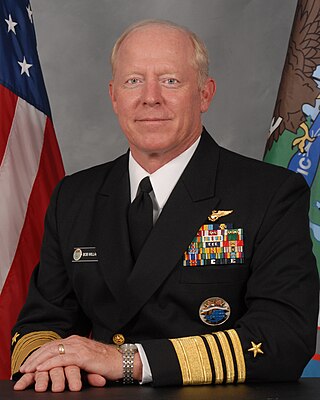Top Qs
Timeline
Chat
Perspective
Robert F. Willard
United States Navy admiral From Wikipedia, the free encyclopedia
Remove ads
Robert Frederick Willard[1] is a retired United States Navy admiral who last served as the 22nd Commander, U.S. Pacific Command from October 19, 2009[2] to March 9, 2012. He previously served as Commander, U.S. Pacific Fleet from May 8, 2007, to September 25, 2009.[3][4] Prior to that, he served as the 34th Vice Chief of Naval Operations from March 18, 2005, to April 2007. On March 9, 2012, Admiral Willard retired from the Navy after 39 years of service. On May 9, 2012, he was elected president and chief executive officer of the Institute of Nuclear Power Operations, succeeding retired Navy admiral James O. Ellis Jr.
Remove ads
Navy career
Summarize
Perspective


Willard is a Los Angeles native. In 1969, he graduated from East Longmeadow High School[citation needed] in East Longmeadow, Massachusetts, and received a Bachelor of Science degree from the United States Naval Academy in 1973. He also holds a Master of Science degree in engineering management from Old Dominion University and was a fellow at MIT Seminar XXI.
An F-14 naval aviator, Willard served consecutively in Fighter Squadron 24 (VF-24), Fighter Squadron 124 (VF-124), and Fighter Squadron 2 (VF-2) at NAS Miramar, deploying aboard USS Constellation (CV-64), USS Ranger (CV-61), and USS Kitty Hawk (CV-63). He then joined Navy Fighter Weapons School Top Gun as Operations Officer and Executive Officer, as well as aerial coordinator for the Paramount film Top Gun.
In 1987, Willard reported to Fighter Squadron 51 (VF-51), where he served as executive officer and commanding officer of the Screaming Eagles, embarked in USS Carl Vinson (CVN-70). He subsequently attended Navy Nuclear Power Training before rejoining Carl Vinson as Executive Officer. Willard then commanded the flagships USS Tripoli (LPH-10) and USS Abraham Lincoln (CVN-72) in various operations including Somalia, and the Persian Gulf.
As a flag officer, Willard has served on the Joint Staff as Deputy Director for Operations (Current Readiness and Capabilities); Commander. In 1998–1999, he attended MIT Seminar XXI.[5] He also served on Carrier Group Five embarked in USS Kitty Hawk (CV-63); Deputy and Chief of Staff, Commander in Chief, U.S. Pacific Fleet in Pearl Harbor, Hawaii; Commander, Seventh Fleet, embarked in USS Blue Ridge (LCC-19) in Yokosuka, Japan; and Director for Force Structure, Resources and Assessment (DJ8) on the Joint Chiefs of Staff. From March 2005 to April 2007, Willard was the 34th Vice Chief of Naval Operations. After, he was the commander of U.S. Pacific Fleet from May 8, 2007, until September 25, 2009, when he was relieved by Admiral Patrick M. Walsh. As the Commander, U.S. Pacific Fleet, he was responsible for the world's largest fleet command, encompassing 100,000,000 square miles (260,000,000 km2) and more than 170 ships and submarines, 1,300 aircraft, and 122,000 Sailors, Reservists and civilians.
He was named a Distinguished Graduate of the U.S. Naval Academy in late 2018.[6]
Remove ads
Popular culture
Willard appeared in and was a consultant for the 1986 film Top Gun. He pilots the “MiG-28” that receives "the bird" from Goose and Maverick.[7]
In March 2010, a video in which Rep. Hank Johnson expressed his concern to Willard that the island of Guam might "capsize" and "tip over" due to overpopulation of military equipment and personnel went viral, garnering hundreds of thousands of views from thehill.com, hotair.com and latimes.com and was ultimately seen over three million times.[8] Willard reassured the Congressman, "we don't anticipate that", for which he received wide popular admiration.[9][10][11]
Remove ads
Awards and decorations
 |
 |
References
External links
Wikiwand - on
Seamless Wikipedia browsing. On steroids.
Remove ads

